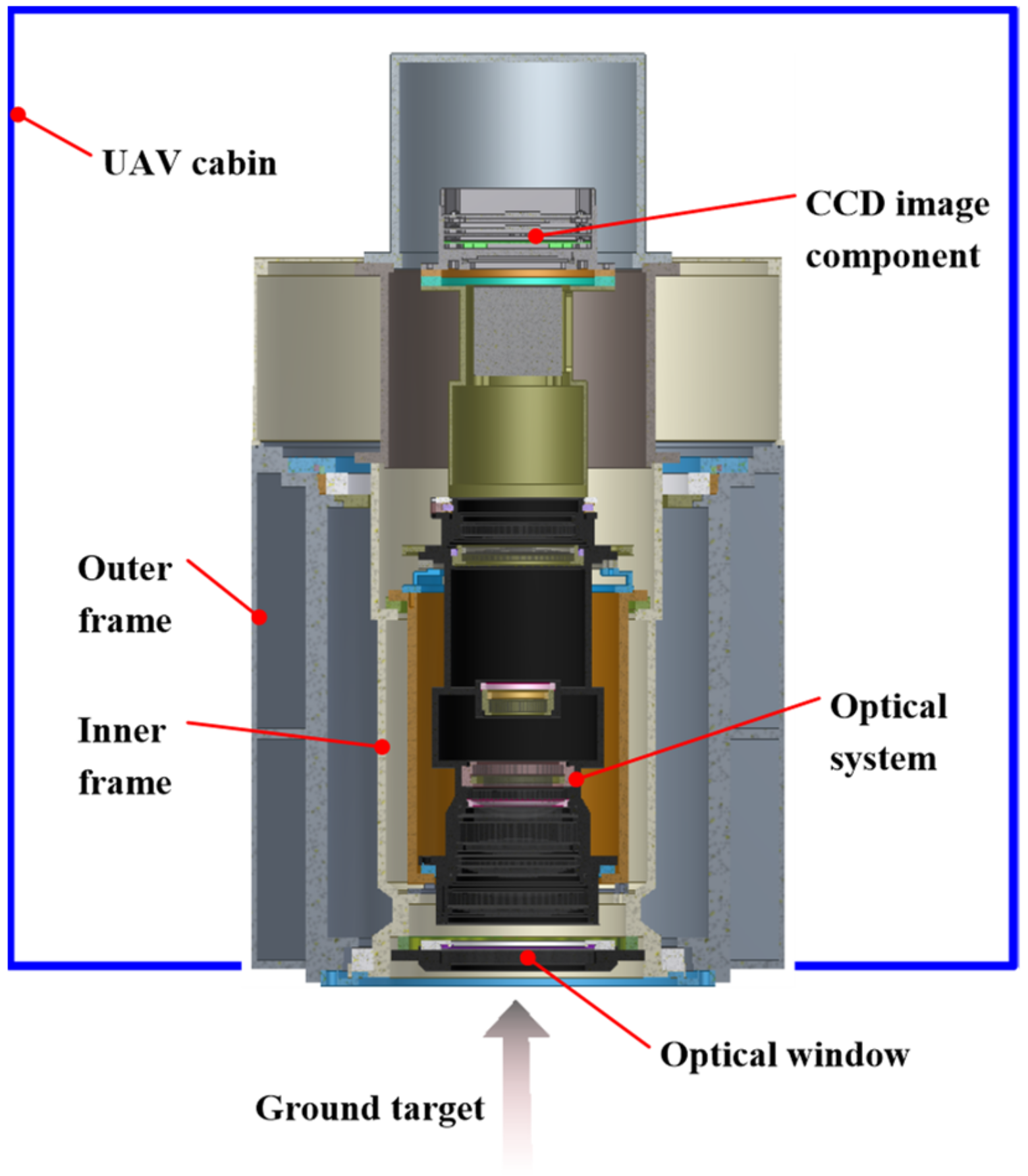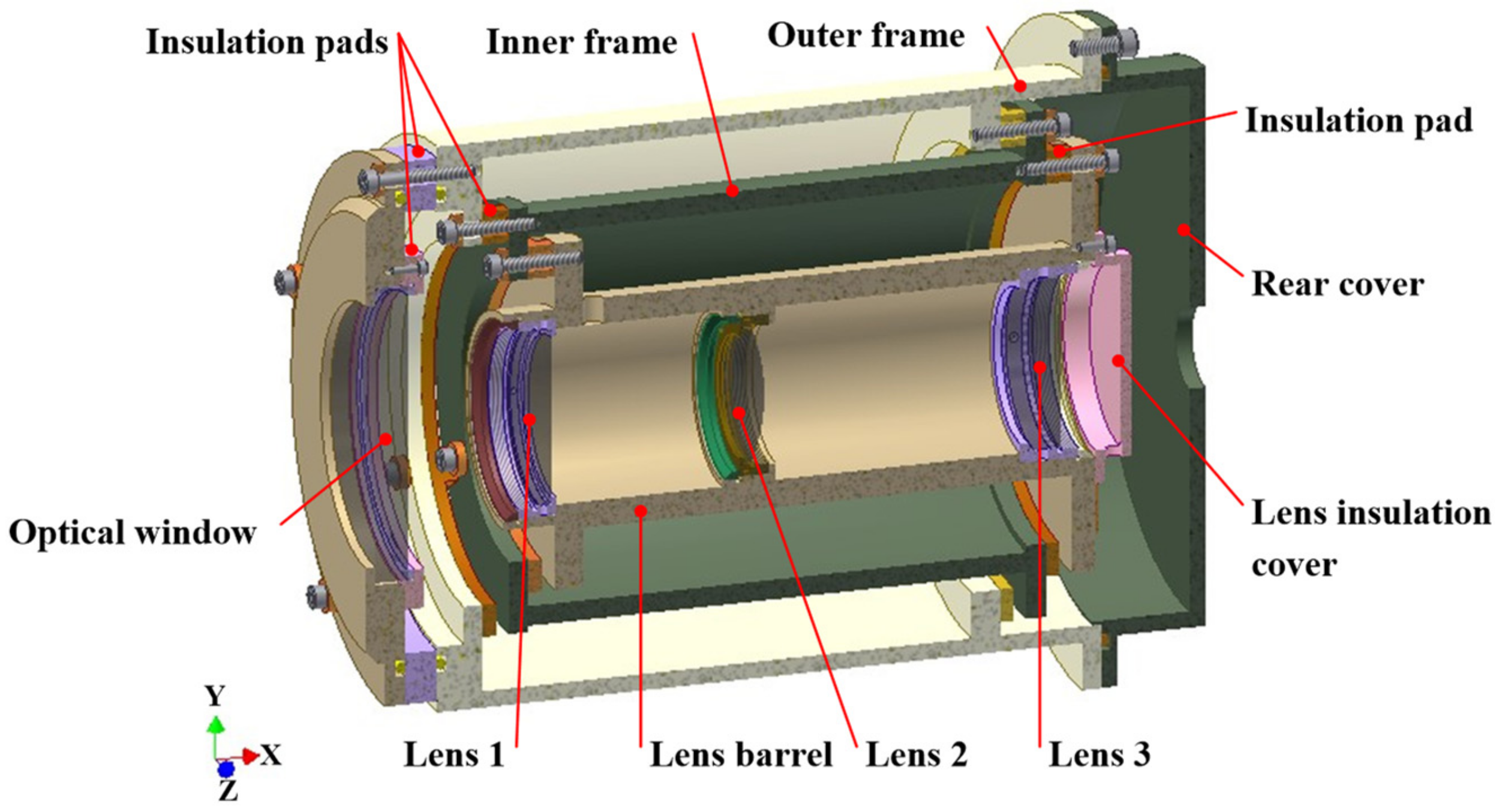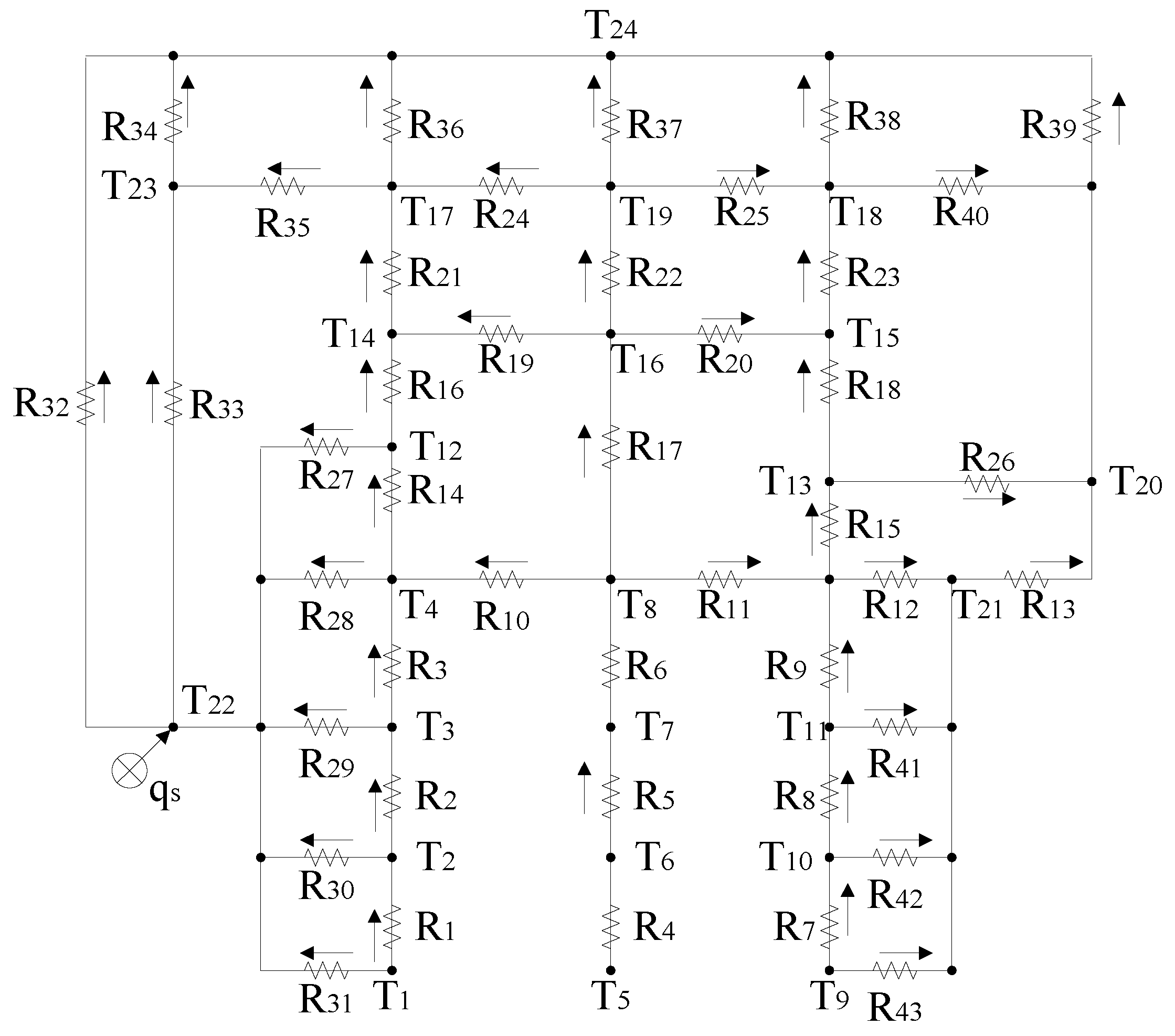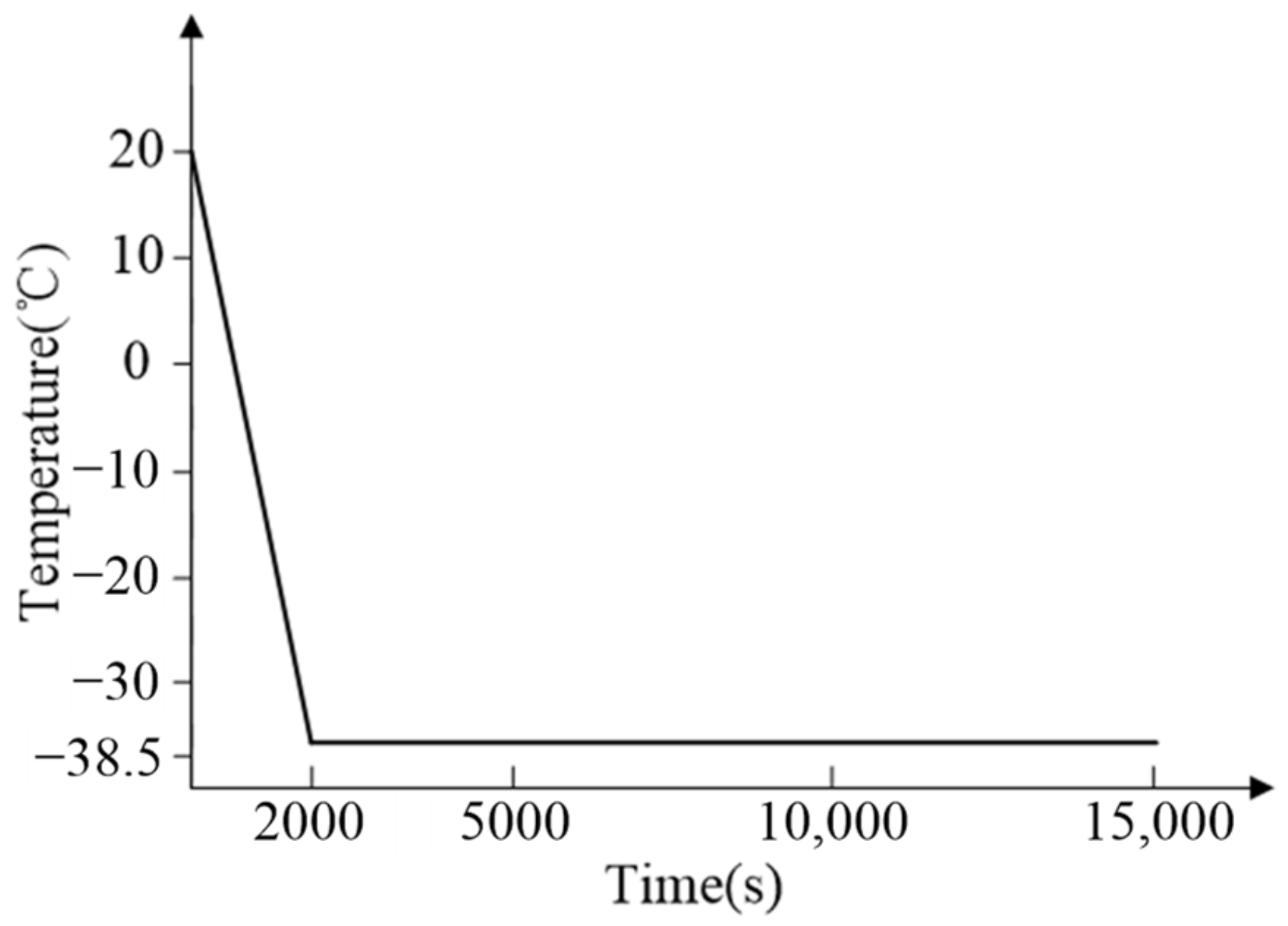Lumped Parameter Thermal Network Modeling and Thermal Optimization Design of an Aerial Camera
Abstract
:1. Introduction
2. Introduction of the Aerial Camera
2.1. Thermal Environment
2.2. Effects of Temperature Variations on Optical Systems
2.3. Experimental Aerial Camera
3. LPTN Modeling
3.1. Thermal Network Node Model
3.2. Thermal Network Mathematical Model
3.3. Heat Leakage Analysis
4. Thermal Optimization Design
4.1. Arrangement of Heating Zones
4.2. Thermal Control Strategy
5. Thermal Control Experiment
6. Conclusions
Author Contributions
Funding
Data Availability Statement
Conflicts of Interest
Appendix A
| R1 | 16.78 | R2 | 11.7 | R3 | 5.12 |
| R4 | 22.52 | R5 | 17.34 | R6 | 8.92 |
| R7 | 13.5 | R8 | 8 | R9 | 2.79 |
| R10 | 0.27 | R11 | 0.37 | R12 | 0.54 |
| R13 | |||||
| R14 | 0.15 | R15 | 0.11 | R16 | 51.4 |
| R17 | |||||
| R18 | 51.3 | R19 | 0.22 | R20 | 0.22 |
| R21 | 51.3 | R22 | |||
| R23 | 51 | R24 | 0.19 | R25 | 0.23 |
| R26 | |||||
| R27 | |||||
| R28 | |||||
| R29 | |||||
| R30 | |||||
| R31 | |||||
| R32 | R33 | 11.14 | |||
| R34 | |||||
| R35 | 5.12 | R36 | |||
| R37 | |||||
| R38 | |||||
| R39 | |||||
| R40 | 0.27 | R41 | |||
| R42 | |||||
| R43 | |||||
References
- Held, K.J.; Robinson, B.H. TIER II Plus Airborne EO Sensor LOS Control and Image Geolocation. In Proceedings of the 1997 IEEE Aerospace Conference, Aspen, CO, USA, 14–17 July 1997; Volume 372, pp. 377–405. [Google Scholar]
- Lareau, A.G.; Partynski, A.J.; Fishell, W.G. Dual-band framing cameras: Technology and status. Proc. SPIE-Int. Soc. Opt. Eng. 2000, 4127, 148–156. [Google Scholar]
- Colomina, I.; Molina, P. Unmanned aerial systems for photogrammetry and remote sensing: A review. ISPRS J Photogramm. 2014, 92, 79–97. [Google Scholar] [CrossRef]
- Sun, B.; Zhu, J.; Yang, L.; Yang, S.; Niu, Z. Calibration of line-scan cameras for precision measurement. Appl. Opt. 2016, 55, 6836–6843. [Google Scholar] [CrossRef]
- Jakel, E.; Erne, W.; Soulat, G. The thermal control system of the Faint Object Camera. In Proceedings of the 15th Thermophysics Conference, Snowmass, CO, USA, 14–16 July 1980; p. 1501. [Google Scholar]
- Yang, H.; Yuan, G.; Pan, J.; Zhou, D. Environmental Stability Design of the Aerial Mapping Camera Based on Multi-Dimensional Compound Structure. Sensors 2023, 23, 4421. [Google Scholar] [CrossRef]
- Li, Y.; Yuan, G.; Xie, X.; Dong, L.; Yin, L. Multilayer thermal control for high-altitude vertical imaging aerial cameras. Appl. Opt. 2022, 61, 5205–5214. [Google Scholar] [CrossRef]
- Liu, F.; Cheng, Z.; Jia, P.; Zhang, B.; Hu, R. Impact of thermal control measures on the imaging quality of an aerial optoelectronic sensor. Sensors 2019, 19, 2753. [Google Scholar] [CrossRef]
- Liu, W.; Shen, H.; Xu, Y.; Song, Y.; Li, H.; Jia, J.; Ding, Y. Developing a thermal control strategy with the method of integrated analysis and experimental verification. Optik 2015, 126, 2378–2382. [Google Scholar] [CrossRef]
- Zhang, M.; Lu, Q.; Tian, H.; Wang, D.; Chen, C.; Wang, X. Design and Optimization for Mounting Primary Mirror with Reduced Sensitivity to Temperature Change in an Aerial Optoelectronic Sensor. Sensors 2021, 21, 7993. [Google Scholar] [CrossRef]
- Cheng, Z.; Sun, L.; Liu, F.; Liu, X.; Li, L.; Li, Q.; Hu, R. Engineering design of an active–passive combined thermal control technology for an aerial optoelectronic platform. Sensors 2019, 19, 5241. [Google Scholar] [CrossRef]
- Lee, H.P. Application of Finite-Element Method in the Computation of Temperature with Emphasis on Radiative Exchanges; AIAA, 72-274; NASA Goddard Space Flight Center: Greenbelt, MD, USA, 1972. [Google Scholar]
- Lee, H.P.; Jackson, C.E. Finite-element solution for a combined radiative-conductive analysis with mixed diffuse-specular surface characteristics. In Proceedings of the 10th Thermophysics Conference, Denver, CO, USA, 27–29 May 1975. AIAA, 75-682. [Google Scholar]
- Ravinder, K.; Ravindra, B. Thermal characteristics of a classical solar telescope primary mirror. New Astron. 2011, 16, 328–336. [Google Scholar]
- Liu, W.; Ding, Y.; Wu, Q.; Jia, J.; Guo, L.; Wang, L. Thermal analysis and design of the aerial camera’s primary optical system components. Appl. Therm. Eng. 2012, 38, 40–47. [Google Scholar] [CrossRef]
- Gao, Y.; Zhang, B.; Chen, L.; Xu, B.; Gu, G. Thermal design and analysis of the high resolution MWIR/LWIR aerial camera. Optik 2019, 179, 37–46. [Google Scholar] [CrossRef]
- Borden, M.; Lewis, D.; Ochoa, H.; Jones-Wilson, L.; Susca, S.; Porter, M. Thermal, Structural, and Optical Analysis of a Balloon-Based Imaging System. Publ. Astron. Soc. Pac. 2017, 129, 035001. [Google Scholar] [CrossRef]
- Cui, Q.; Lin, G.; Cao, D.; Zhang, Z.; Wang, S.; Huang, Y. Thermal design parameters analysis and model updating using Kriging model for space instruments. Int. J. Therm. Sci. 2022, 171, 107239. [Google Scholar] [CrossRef]
- Ishimoto, T.; Pan, H.M. Thermal network correction techniques. In Proceedings of the 5th Thermophysics Conference, Los Angeles, CA, USA, 29 June–1 July 1970. AIAA-70-821. [Google Scholar]
- Weng, J.; Pan, Z. A correction method for spacecraft thermal network and its coefficients. Chin. Space Sci. Technol. 1995, 4, 10–14. [Google Scholar]
- Liu, Y.; Li, G.; Jiang, L. A new improved solution to thermal network problem in heat-transfer analysis of spacecraft. Aerosp. Sci. Technol. 2010, 14, 225–234. [Google Scholar] [CrossRef]
- Edeson, R.L.; Shaughnessy, B.M.; Whalley, M.S.; Burke, K.; Lucas, J. The mechanical and thermal design and analysis of the VISTA infrared camera. In Modeling and Systems Engineering for Astronomy; SPIE: Glasgow, UK, 2004; Volume 5497, pp. 508–519. [Google Scholar]
- Xue, Z.; Wang, C.; Yu, Y.; Wang, P.-P.; Zhang, H.-Y.; Sui, Y.-Y.; Li, M.; Luo, Z.-Y. Integrated optomechanical analyses and experimental verification for a thermal system of an aerial camera. Appl. Opt. 2019, 58, 6996–7005. [Google Scholar] [CrossRef]
- Fan, Y.; Liang, W.; Ma, W. Thermal design of the optical system in an aerial camera. Opto Electron. Eng. 2013, 40, 51–58. [Google Scholar]
- Incropera, F.P.; DeWitt, D.P.; Bergman, T.L.; Lavine, A.S. Fundanmentals of Heat and Mass Transfer; John Wiley & Sons, Inc.: New York, NY, USA, 1985; pp. 251–253. [Google Scholar]












| Type | Value (°C) | MTF | MTF Requirement |
|---|---|---|---|
| Temperature level | −20 | 0.506 | >0.504 |
| 0 | 0.513 | ||
| 20 | 0.52 | ||
| Radial temperature gradient | 3 | 0.495 | >0.480 |
| 5 | 0.483 | ||
| 6 | 0.475 | ||
| Axial temperature gradient | 5 | 0.508 | >0.480 |
| 7 | 0.476 | ||
| 10 | 0.467 |
| Node Number | Location | Material | Thermal Conductivity/W·m−1·°C−1 | Surface Emissivity | Thermal Capacity/J·°C−1 |
|---|---|---|---|---|---|
| 1~3 | Lens 1 | NBK7 | 1.114 | 0.9 | 4.5/13.5/15.8 |
| 4 | Lens barrel | LY12 | 160 | 0.8 | 51.1 |
| 5~7 | Lens 2 | NBK7 | 1.114 | 0.9 | 2.3/4.5/6.8 |
| 8 | Lens barrel | LY12 | 160 | 0.8 | 755.3 |
| 9~11 | Lens 3 | NBK7 | 1.114 | 0.9 | 4.5/15.8/27 |
| 12~13 | Lens barrel | LY12 | 160 | 0.8 | 121/177.4 |
| 14~16 | Inner frame | LY12 | 160 | 0.07 | 1216/150.5/930.1 |
| 17~19 | Outer frame | LY12 | 160 | 0.07 | 414/572.5/1064.4 |
| 20 | Rear cover | LY12 | 160 | 0.07 | 602.1 |
| 21 | Lens insulation cover | LY12 | 160 | 0.07 | 48.4 |
| 22 | Optical window | NBK7 | 1.114 | 0.6 | 144 |
| 23 | Window barrel | LY12 | 160 | 0.8 | 389.8 |
| Location | Lenses | Optical Window | ||||
|---|---|---|---|---|---|---|
| Node | 8 | 12 | 13 | 21 | 22 | 23 |
| Heat leakage rate (W) | q5 = 2.8 | q4 = 0.4 | q6 + q7 = 2.2 | q8 = 1 | q1 = 2 | q2 + q3 = 17.9 |
| Total heat leakage rate (W) | 26.3 | |||||
Disclaimer/Publisher’s Note: The statements, opinions and data contained in all publications are solely those of the individual author(s) and contributor(s) and not of MDPI and/or the editor(s). MDPI and/or the editor(s) disclaim responsibility for any injury to people or property resulting from any ideas, methods, instructions or products referred to in the content. |
© 2024 by the authors. Licensee MDPI, Basel, Switzerland. This article is an open access article distributed under the terms and conditions of the Creative Commons Attribution (CC BY) license (https://creativecommons.org/licenses/by/4.0/).
Share and Cite
Fan, Y.; Feng, W.; Ren, Z.; Liu, B.; Wang, D. Lumped Parameter Thermal Network Modeling and Thermal Optimization Design of an Aerial Camera. Sensors 2024, 24, 3982. https://doi.org/10.3390/s24123982
Fan Y, Feng W, Ren Z, Liu B, Wang D. Lumped Parameter Thermal Network Modeling and Thermal Optimization Design of an Aerial Camera. Sensors. 2024; 24(12):3982. https://doi.org/10.3390/s24123982
Chicago/Turabian StyleFan, Yue, Wei Feng, Zhenxing Ren, Bingqi Liu, and Dazhi Wang. 2024. "Lumped Parameter Thermal Network Modeling and Thermal Optimization Design of an Aerial Camera" Sensors 24, no. 12: 3982. https://doi.org/10.3390/s24123982






